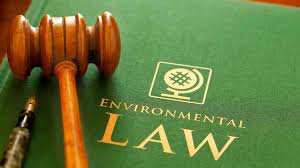Environmental law refers to a branch of legal regulations and principles that govern the interactions between human activities and the environment.
It encompasses rules and statutes designed to protect and manage natural resources, control pollution, conserve biodiversity, and address various environmental issues.
Environmental laws are created to ensure the sustainable use and preservation of the environment for present and future generations.
In our rapidly changing world, the importance of protecting the environment cannot be overstated. Environmental law plays a pivotal role in this endeavor, serving as the legal framework that guides our actions and decisions concerning the natural world.
What is Environmental Law?
At its core, environmental law is a set of rules and regulations aimed at preserving and safeguarding our environment. It’s like the rulebook for how we interact with nature. These laws are designed to ensure that human activities, from building houses to running factories, don’t harm the planet irreparably.
Why Do We Need Environmental Law?
Imagine a world without environmental laws. Companies could freely pollute the air and water, forests could be cut down without restraint, and endangered species might vanish forever. Environmental laws prevent these scenarios and provide a path toward a sustainable future.
Key Components of Environmental Law
1. Pollution Control: Environmental laws set limits on the amount of pollutants that can be released into the air, water, and soil. This helps keep our air breathable, our water drinkable, and our soil fertile.
2. Conservation of Natural Resources: They promote the responsible use of natural resources like forests, minerals, and wildlife. This ensures that these resources are available for future generations.
3. Biodiversity Protection: These laws work to protect endangered species and their habitats, preventing the loss of critical components of our ecosystems.
4. Land Use Planning: Environmental laws guide how land can be used, helping to prevent overdevelopment and maintain green spaces.
5. International Cooperation: Many environmental issues, like climate change, are global in nature. Environmental law also encompasses international agreements and treaties aimed at addressing these issues collectively.
Read Also: The Impact of Water Conservation on the Environment
Challenges in Environmental Law

While environmental laws are crucial, they do face challenges. Balancing economic growth with environmental protection can be tricky. Sometimes, there are conflicts between industries and environmentalists about what should take precedence.
Moreover, enforcing environmental laws can be complex, especially when violations occur across borders or in remote areas. Legal systems around the world must work together to tackle these issues effectively.
The Role of Individuals
Environmental law isn’t just for governments and corporations. Individuals can play a crucial role too. By being aware of environmental laws, reducing personal pollution, conserving resources, and supporting eco-friendly initiatives, everyone can contribute to a healthier planet.
Environmental law is the legal backbone of our efforts to protect the environment. It ensures that we don’t harm the planet beyond repair and lays the groundwork for a sustainable future. By understanding and respecting these laws, we can work together to preserve our planet for generations to come.
Types of Environmental Law
Environmental law is like a big umbrella, covering various aspects of our relationship with the environment. Let’s take a stroll through the different types of environmental laws in simple terms.
1. Pollution Control Laws: These laws are like the clean-up crew for our environment. They set rules on how much pollution factories and cars can release into the air and water. By doing this, they help keep our air and water clean and safe to use.
2. Conservation Laws: Imagine a treasure chest filled with precious resources like forests, minerals, and wildlife. Conservation laws are like the key to that chest. They guide us on how to use these resources wisely, so they don’t run out. These laws make sure future generations can enjoy them too.
3. Endangered Species Laws: Some animals and plants are like rare gems, they are endangered and close to disappearing forever. Endangered species laws are like protective shields around them. They make it illegal to harm or kill these special creatures and help them make a comeback.
4. Land Use Laws: They help prevent overcrowding, so there’s space for homes, farms, and green areas like parks. These laws also protect unique places like wetlands and forests from being destroyed.
5. International Environmental Laws: Our Earth is like a giant puzzle, and environmental problems don’t stop at country borders. International environmental laws are like the pieces that fit together. They help countries work together to tackle global issues like climate change and protect our shared planet.
6. Wildlife Protection Laws: The world is home to many amazing creatures. Wildlife protection laws are like their guardians. They make sure animals are treated with kindness and not harmed or captured without good reason.
7. Environmental Impact Assessment Laws: Before big projects like building a dam or a highway, we need to understand how they’ll affect the environment. These laws make sure that before we start such projects, we study and understand their impact and try to reduce any harm.
8. Renewable Energy Laws: To power our homes and businesses, we often use fossil fuels that harm the environment. Renewable energy laws encourage the use of cleaner sources like wind, solar, and hydropower. They help us reduce pollution and fight climate change.
9. Waste Management Laws: We produce a lot of waste, from packaging to old electronics. Waste management laws tell us how to handle this waste properly. They promote recycling and safe disposal methods to keep our neighborhoods clean and safe.
10. Noise Pollution Laws: Too much noise can be harmful to our health and the environment. These laws set limits on noise levels in our communities to ensure we can enjoy peace and quiet.
These types of environmental laws work together to protect our planet. They help us live in harmony with the environment, ensuring that our actions don’t harm the Earth and its creatures. By following these laws, we can enjoy the beauty of our world while preserving it for generations to come.
Read Also: 4 Batteries Recycling Process Complete Guide
The Importance of Environmental Law

A world without rules to protect our environment. It would be a world where the air we breathe is thick with pollution, where our water is unsafe to drink, and where wild creatures vanish forever. That’s why environmental law is so vital – it’s the shield that guards our planet.
Why Do We Need Environmental Law?
Think of environmental law as our planet’s bodyguard. Its job is to make sure we treat the Earth kindly and don’t harm it. Without these laws, there would be chaos, and our beautiful world would suffer.
1. Clean Air and Water: One big job of environmental law is to keep the air clean and the water pure. These laws tell factories and cars how much pollution they can make. That way, we can breathe fresh air and drink water without worrying about getting sick.
2. Protecting Nature’s Beauty: Imagine if no one cared about the forests, the mountains, and the oceans. Environmental laws are like a promise to protect these places. They make sure that we don’t chop down all the trees, dig up all the minerals, or harm the animals that call these places home.
3. Saving Endangered Friends: Some animals and plants are in danger of disappearing forever. Environmental laws work to save these endangered species. They give these special creatures a fighting chance to survive and thrive.
4. Smart Land Use: We need space to live and work, but we also need green places to play and relax. Environmental laws help us decide how to use our land wisely. They make sure we don’t build too much and destroy the beauty of our world.
5. Working Together Globally: The Earth is big and many environmental problems are too big for one country to fix. That is why countries around the world team up with international agreements and treaties. Together, they tackle global issues like climate change.
6. Challenges and Debates: While environmental laws are crucial, they can sometimes cause debates. Some people worry that strict laws might slow down businesses and jobs. Finding the right balance between protecting the environment and supporting the economy is a challenge.
7. Everyone’s Role: Environmental law isn’t just for big governments and companies. You and I can be superheroes for the environment too. We can save energy, reduce waste, and support eco-friendly practices. When we follow the law and do our part, we’re helping our planet stay healthy.
Environmental law is like a guiding star that shows us how to live on this amazing planet without harming it. It’s not just a set of rules; it’s a promise to protect the Earth for today and tomorrow. By following these laws and caring for our environment, we’re ensuring a bright future for all living things on our beautiful blue planet.
Read Also: 16 Medicinal Health Benefits Of Platycodon (Balloon Flower)

